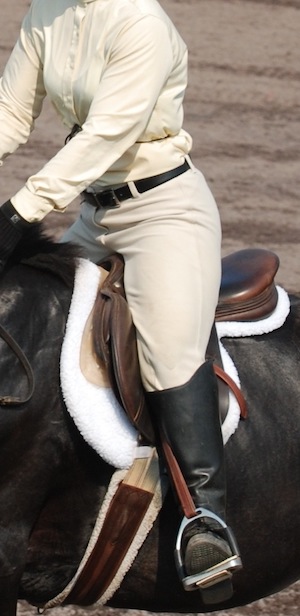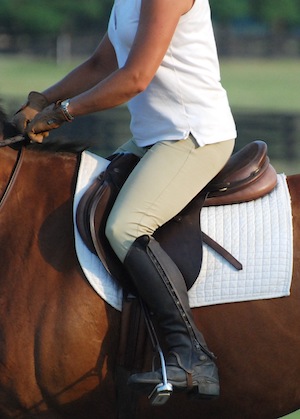
#92 Change your Rising Diagonal in the Air
Copyright© 2013. All rights reserved.
Do you push off your feet in rising trot? Tend to fall back into the saddle? Ride the “down beat”? Have difficulty getting your horse to lengthen his trot stride? Alternating between changing your diagonals sitting and rising can help. When you can maintain your balance and keep to a steady rhythm your horse’s trot will become regular and smooth.
Next time you ride notice how your rise the trot. Are your thighs away from the saddle? Feet pushed forward? Do you fall back to the cantle? Do you put all of your weight on the stirrups in an attempt to push yourself out of the saddle?
Standing against the stirrups to rise makes you unstable especially if your knees are turned out. This leaves the stirrups as the only place to put your weight but since the stirrup acts like a pendulum this isn’t such a good idea! The moment you push, the stirrup swings out from under you causing you to fall back onto your horse! This causes him to shorten his stride and hollow his back making it harder for you to rise.
You need to be able to maintain your balance in rising trot and come back to the saddle without falling. The thrust from the horse should send you up. Catching your weight on your thighs keeps you stable and allows you to lower yourself rather than fall back on the sit phase. Your thighs should be part of your weight-bearing surface area in order to eliminate the pendulum swing of the stirrups. This doesn’t mean you have to pinch with your knees. But you do want to allow your inner thigh to make contact from just below your groin down to the knee. Distributing your weight over a large surface area decreases the pressure on your horse’s back and increases your stability.
To stop pushing off your stirrups and help find your thigh support do the following exercise. Change your rising diagonal in the air instead of when you are sitting in the saddle. This means you stay up an extra beat. At first this will feel quite awkward and you may find it quite difficult. But stick with it as it has major payoffs! Say to yourself “up, up!” when changing diagonals. Let your weight rest on your thighs. You might have to lift your heels a little until you feel your feet come under you. Or you may have to internally rotate your hips and let go in your buttock muscles so that the flat of your thigh is on the saddle. To get the feeling of internal rotation stand on the ground with your knees and toes touching. Feel how you have to widen across your buttocks to turn inward. You don’t need this just in the saddle, just enough to stop externally rotating, in other words bring your thigh into a neutral position. The key is to internally rotate from the hips not from the feet, which could hurt your knees!
After you get the idea of changing while in the air, change your diagonal in the air every 5 strides. Once accomplished, decrease to 4, and then every 3 strides. The trot should remain the same speed and rhythm. Go back to every 5 strides and alternate changing your diagonal sitting and rising. Does your horse lose his rhythm? If so you may be losing your balance. Continue to practice until your horse’s maintains the same trot. Decrease the number of strides between changes of diagonal and be sure to do this tracking both left and right. Can you continue to change your diagonals as you change direction?
Use this Murdoch Minute to find your thigh support in rising trot. When your weight is distributed on your thigh you will alleviate your horse’s back, become more secure, improve the quality of your horse’s trot and always remember to enjoy the ride!





